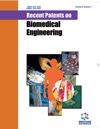- Home
- A-Z Publications
- Recent Patents on Biomedical Engineering (Discontinued)
- Previous Issues
- Volume 5, Issue 3, 2012
Recent Patents on Biomedical Engineering (Discontinued) - Volume 5, Issue 3, 2012
Volume 5, Issue 3, 2012
-
-
Materials for Articular Cartilage Regeneration
More LessAuthors: Aysegul Tombuloglu, Ayse B. Tekinay and Mustafa O. GulerMany health problems remaining to be untreatable throughout the human history can be overcome by utilizing new biomedical materials. Healing cartilage defects is one of the problems causing significant health issue due to low regeneration capacity of the cartilage tissue. Scaffolds as three-dimensional functional networks provide promising tools for complete regeneration of the cartilage tissue. Diversity of materials and fab Read More
-
-
-
A Review of Recent Advances in Upper Extremity Orthoses for Rehabilitation Therapy and Improved Functional Independence
More LessOrthoses are a form of exoskeleton that attach to a limb or to the torso. Upper extremity orthoses have been developed in response to two distinct needs; improved rehabilitation therapy and devices that aid persons with disabilities in performing activities of daily living. In the past, therapists have provided therapy to those affected by conditions such as stroke by repetitive manipulation of the affected body segments. Several Read More
-
-
-
Review of Recent Patents on Foldable Ventricular Assist Devices
More LessCongestive heart failure accounts for a high morbidity worldwide. The only effective treatment for end-stage patients is heart transplantation or, in light of the shortage of suitable donors, an artificial heart or ventricular assist device (VAD). The newer-generation continuous-flow rotary VADs allow for a significant reduction in size and an improvement in reliability. However, the invasive implantation still limits this technology fr Read More
-
-
-
Recent Patents on Quantum Dot Engineering for Biomedical Application
More LessBy Yu KeQuantum dots (QDs) are nanometer-scale crystals, which have tunable fluorescence signatures, narrow emission spectra, brighter emissions and good photostability. These properties enable QDs as powerful inorganic fluorescent probes for biological applications, such as imaging (in vitro and in vivo), biosensing, biolabeling, gene expression studies, protein studies or medical diagnostics. High quality QDs are usually synthesized Read More
-
-
-
Recent Advances in Transcatheter Heart Valve Replacement: A Review on Aortic and Mitral Implantation
More LessAuthors: Munirah Ismail, Jimmy Kim Fatt Hon, Zhi Wei Chan and Hwa Liang LeoHeart valve disease is a serious problem, especially in aging societies. If left untreated, many patients can die from the disease itself or complications associated with it. However, many are denied open-heart replacement surgeries due to advanced age and co-morbidities. Thus, other solutions had to be explored. One successful solution is transcatheter heart valve implantation and is now seen as the only viable t Read More
-
-
-
Exfoliated Epithelial Cells: A Non-Invasive way to Evaluate the Physiological State of Gastrointestinal Epithelium
More LessAuthors: B. Kaeffer and J.C. RozeIn medicine, exploration of the digestive tract by non-invasive means is designed to improve patient monitoring. Exfoliated epithelial cells can be isolated from several body fluids (i.e., breast milk, urines, and digestive fluids) as a cellular mixture (senescent, apoptotic, proliferative, or quiescent cells). Exfoliation is a phenomenon that participates in the maintenance and evolution of the mucosal architecture. By quantifying the de Read More
-
-
-
Golay Coding for Penetration Depth Improvement in Ultrasonography GCPDIU
More LessAuthors: Roger Mboupda Pone, Alain Tiedeu, Martin Kom and Godpromesse KenneIn ultrasound imaging, radiologists often need to attain different penetration depths. It is well known that the maximum penetration depth decreases when the frequency of the ultrasound increases. Based on related research and reviewing of recent patents, we suggest an approach based on Golay coding to improve the penetration depth. During our simulations, we successfully achieved a maximum penetration dept Read More
-
Most Read This Month
Article
content/journals/biomeng
Journal
10
5
false
en


